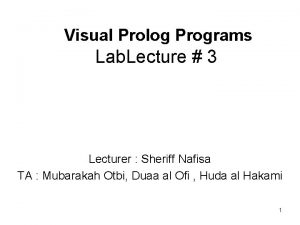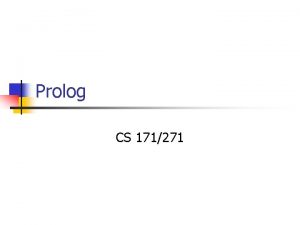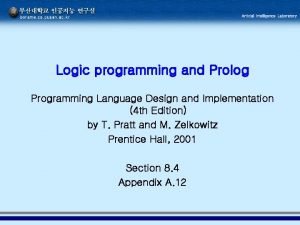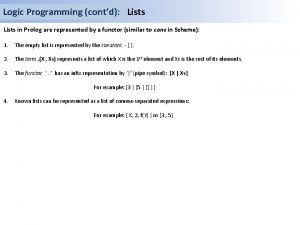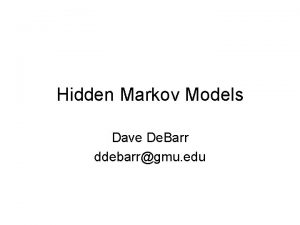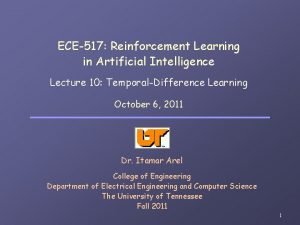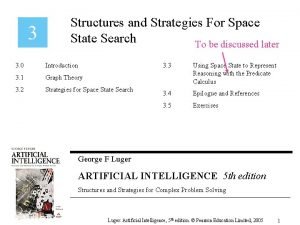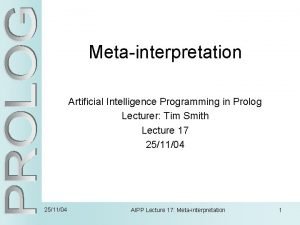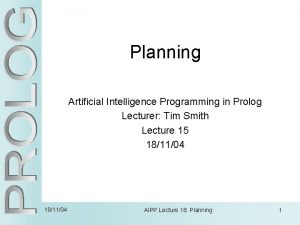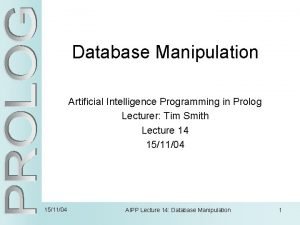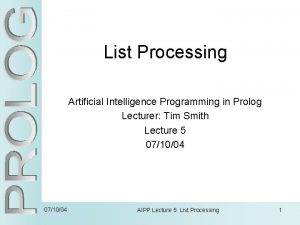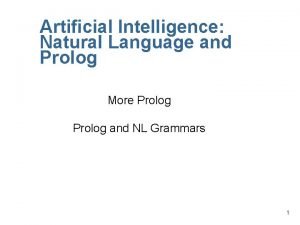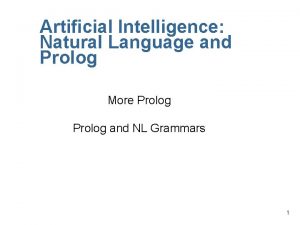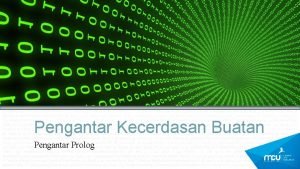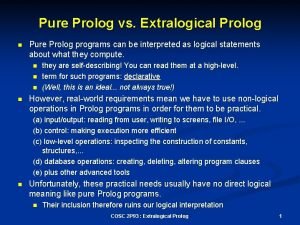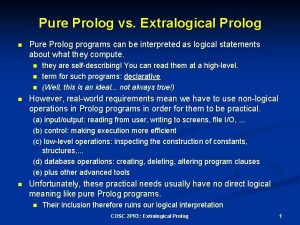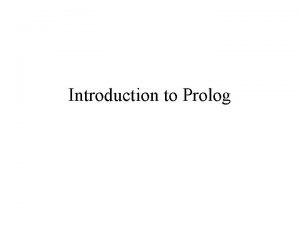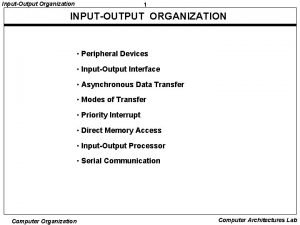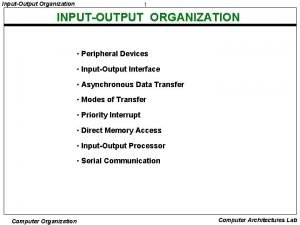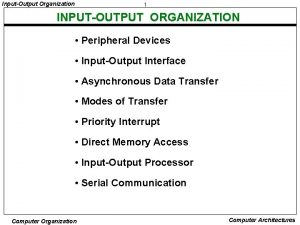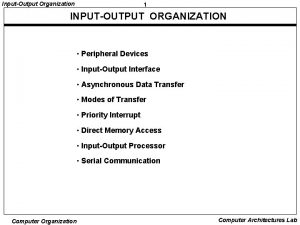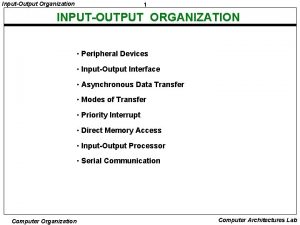InputOutput Artificial Intelligence Programming in Prolog Lecturer Tim























![Built-in I/O Predicates write/[1, 2] nl/[0, 1] tab/[1, 2] get 0/[1, 2] see/1 seeing/1 Built-in I/O Predicates write/[1, 2] nl/[0, 1] tab/[1, 2] get 0/[1, 2] see/1 seeing/1](https://slidetodoc.com/presentation_image_h/18d2be8cb81d201411d7ac17c6cdfb2a/image-24.jpg)
- Slides: 24

Input/Output Artificial Intelligence Programming in Prolog Lecturer: Tim Smith Lecture 12 04/11/04 AIPP Lecture 12: I/O 1

Input/Output in Prolog • Input/output (I/O) is not a significant part of Prolog. • Part of the reason for this is that the purpose of Prolog is declarative programming, and input/output is intrinsically about producing procedural side-effects. • It is very hard to state what the logical reading of a Prolog program is when it contains I/O functions. • The I/O facilities I will present here are relatively simple. Each implementation of Prolog has more advanced I/O facilities but these will not be covered in this course. • As I/O is not a core part of Prolog you will not be examined upon it but you may need to use it in practical exercises. 04/11/04 AIPP Lecture 12: I/O 2

How I/O works in Prolog. • At any time during execution of a Prolog program two files are ‘active’: – a current input stream, and – a current output stream. • By default these are both set to user which means that – all input will come from the user terminal (the shell window in which Sicstus is loaded) and – all output will be sent to the user terminal (i. e. write to the screen). • Multiple I/O streams can be initialised but only one input and one output can be ‘active’ at any time (i. e. be read from or written to). 04/11/04 AIPP Lecture 12: I/O 3

File-based I/O: write/1 • We have already used Prolog’s default output predicate write/1. • This prints a term to the current output stream. ? - write(c), write(u_l), write(8), write(r). cu_l 8 r writes to terminal by default. yes ? - write([a, b, c, d]). [a, b, c, d] yes • It will only accept Prolog terms so strings must be enclosed within single quotation marks. ? - write(Hello World). syntax error 04/11/04 ? - write(‘Hello World’). Hello World yes AIPP Lecture 12: I/O 4

Formatting Output • We can use built-in predicates to format the output: – nl/0 = write a new line to the current output stream. – tab/1 = write a specified number of white spaces to the current output stream. • this prints single spaces not actual tabs! |? - write(a), tab(3), write(b), nl, tab(1), write(c), tab(1), write(d), nl, tab(2), write(e). a b c d e yes • We can add syntax by writing string fragments. |? - Day=04, Mth=11, Year=04, write(Day), write('/'), write(Mth), write('/'), write(Year). 4/11/4 04/11/04 Day=4, Mth=11, Year=4, yes AIPP Lecture 12: I/O 5

Writing ASCII characters • Instead of writing syntax as strings we can use the corresponding ASCII codes (see http: //www. asciitable. com/). • An ASCII code is a number between 1 and 127 that refers to a typographical character. – A-Z = 65 -90 – a-z = 97 -122 • put/1 takes a single ASCII code as an argument and writes the corresponding character to the current output stream. | ? - put(65), put(44), put(66), put(46). A, B. yes • This can be useful as ASCII codes can have arithmetic operations performed upon them: | ? - X=32, put(65+X), put(44), put(66+X), put(46). a, b. By adding 32 to each code we can change case. X = 32 ? yes 04/11/04 AIPP Lecture 12: I/O 6

ASCII codes 04/11/04 AIPP Lecture 12: I/O 7

Writing lists of characters • Instead of just writing single terms it is often useful to write out the contents of a list. • We can define a recursive predicate writelist/1 to do this: writelist([]). writelist([H|T]): write(H), writelist(T). |? - X=‘Bob’, writelist([‘The’, ’ ‘, man, ’ was called ‘, X, ’. ’]). The man was called Bob. yes • We can also define a predicate to translate lists of ASCII codes: putlist([]). putlist([H|T]): put(H), putlist(T). 04/11/04 | ? - putlist([65, 44, 66, 46]). A, B. yes AIPP Lecture 12: I/O 8

Writing lists of characters (2) • Either of these could be made to automatically format our output as we wished. writelist 2([H]): write(H), put(46), !. writelist 2([H|T]): write(H), tab(1), writelist 2(T). writefacts([]). writefacts([[X, Y]|T]): write(X), write('('), write(Y), write(')'), write('. '), nl, writefacts(T). | ? - X='Bob', writelist 2(['The', man, was, called, X]). The man was called Bob. X = 'Bob' ? ; no | ? - writefacts([[big, blue], [tickled, pink]]). big(blue). tickled(pink). yes 04/11/04 AIPP Lecture 12: I/O 9

Changing output stream • We can redirect our output to a specific file using tell/1. tell(Filename). or tell(‘path/from/current/dir/to/Filename’). • This tells Prolog to send all output to the specified file. If the file doesn’t exists it will be created. If the file already exists it will be overwritten. • The current output stream can be identified using telling/1. • This file will remain as the current output stream until either: – another output stream is opened using tell/1, or – the current output stream is closed using told/0 and the output stream returned to user. • This file remains as the current output stream as long as Sicstus remains loaded or it is explicitly closed with told/0. 04/11/04 AIPP Lecture 12: I/O 10

| ? - write('Write to terminal'). Write to terminal yes | ? - telling(X). X = user ? yes | ? - tell('demo/test'). yes file is created or overwritten | ? - telling(X). X = 'demo/test' ? yes | ? - write('Now where does it go? '). yes Text doesn’t appear in file until… | ? - told. yes it is closed. | ? - write('Oh, here it is!'). Oh, here it is! yes 04/11/04 AIPP Lecture 12: I/O 11

Reading input: read/1 • Now that we know how to control our output we need to do the same for our input. • The default input stream is the user terminal. • We can read terms from the terminal using the command read/1. – this displays a prompt ‘|: ’ and waits for the user to input a term followed by a full-stop. | ? - write('What is your name? '), nl, read(X), write('Greetings '), write(X). What is your name? |: tim. Greetings tim X = tim ? yes 04/11/04 AIPP Lecture 12: I/O 12

Reading input: read/1 (2) • read/1 can only recognise Prolog terms finished with a full-stop. |? - read(X). |: hello Waits for full-stop to finish term. . Finds full-stop and succeeds. X = hello? yes • Therefore, strings of text must be enclosed in single quotes. |? - read(X). |: Hi there!. syntax error |? - read(X). |: ‘Hi there!’. X = ‘Hi there!’? yes • Variables are translated into Prolog’s internal representation. |? - read(X). |: blue(Moon). X = blue(_A)? yes 04/11/04 AIPP Lecture 12: I/O 13

Different Quotes • When we are reading strings there are two ways we can input them: – if we enclose them in single quotes (e. g. ‘Hi Bob!’) the string is read verbatim. | ? - read(X). |: 'Hi bob!'. X = 'Hi bob!' ? yes – if we enclose them in double quotes (e. g. “Hi Bob!”) the string is interpreted into the corresponding list of ASCII codes. | ? - read(X). |: "Hi bob!". X = [72, 105, 32, 98, 111, 98, 33] ? yes • It is important to use the right quotes as otherwise you won’t be able to process the input correctly. 04/11/04 AIPP Lecture 12: I/O 14

name/2 • This is not the only way to convert terms into strings of ASCII codes, the built-in predicate name/2 also does this. • We can translate any Prolog term (except a variable) into a list of corresponding ASCII codes using name/2. |? - name(a. Ab. B, L). L = [97, 65, 98, 66] ? yes |? - X=‘Make me ASCII’, name(X, L). L = [77, 97, 101, 32, 109, 101, 32, 65, 83, 67, 73], yes • Or convert lists of ASCII codes into Prolog terms. |? - name(C, [72, 101, 108, 111, 32, 87, 111, 114, 108, 100]). C = ‘Hello World’, yes • These lists are useful as we can use them to segment a sentence and create the input for our DCG parser (next lecture). 04/11/04 AIPP Lecture 12: I/O 15

get-ting characters from input • As well as reading whole terms from the input we can also read individual characters. • get 0/1 (= get-zero) reads a character from the current input stream and returns the character’s ASCII code. | ? - get 0(X). |: A X = 65? yes | ? - get 0(X). white spaces |: h X = 32? Top-level options: … ASCII code for a space • get/1 has virtually the same function except that it will skip over any spaces to find the next printable character. get(X). |: A X = 65? yes get(X). |: X = 104 ? yes h • As both are just reading characters, not terms, they don’t need to be terminated with a full-stop. 04/11/04 AIPP Lecture 12: I/O 16

see-ing an Input file • get/1 and get 0/1 are mostly used for processing text files. – read/1 can only read terms so it would be unable to read a file of flowing text. – get/1 and get 0/1 will read each character and return its ASCII code irrespective of its Prolog object status. • To change our input from a user prompt to a file we use see/1 see(Filename). or see(‘path/from/current/dir/to/Filename’). • We can identify the current input stream using seeing/1. • This file will remain as the current input stream until either: – another input stream is opened using see/1, or – the current input stream is closed using seen/0 returning it to user. 04/11/04 AIPP Lecture 12: I/O 17

read-ing input files • Once the input file is activated using see/1 we can process its content. • If the input file contains Prolog terms then we can read them one at a time Input file ‘colours’ contains: |? X = Y = Z = yes big(blue). tickled(pink). red_mist. see(‘demo/colours’), read(X), read(Y), read(Z). big(blue), tickled(pink), red_mist ? • The file is processed in order and the interpreter remembers where we were so every new call to read/1 reads the next term. • This continues until end_of_file is reached or input is seen/0. 04/11/04 AIPP Lecture 12: I/O 18

Multiple I/O streams • Managing multiple I/O streams is difficult using file-based I/O predicates. • write/1 and read/1 work on the current output and input files respectively. You can not specify which file to read from or write to. • Output is not written to a file until it is closed (told/0) but told only closes the current output stream. Therefore, each output file must be re-activated (tell/1) before it can be closed. – This is a rather verbose way to do it. • If we want to use multiple input and output files we need to use stream-based I/O instead. • A stream is a interpreter generated pointer for a specific file. It allows us to dynamically access the file and move about within it. 04/11/04 AIPP Lecture 12: I/O 19

Stream I/O predicates • There a vast number of complex stream handling predicates (see Sicstus manual). Here are just the basics: • open/3 opens a file for reading or writing. Its arguments are: – the file specification (the name of the file); – the mode in which the file is to be opened (read/write/append); – the stream name (generated by the interpreter). This takes the form '$stream'(2146079208). e. g. open(‘demo/test’, append, Stream). • The stream is initialised when the file is opened, and thereafter the file is referred to using the stream pointer (whatever ‘Stream’ unified with), not using its name. 04/11/04 AIPP Lecture 12: I/O 20

Stream I/O predicates (2) • current_input/1 succeeds if its argument is the current input stream. • current_output/1 succeeds if its argument is the current output stream. • set_input/1 sets the current input stream to be the stream given as its argument (equivalent of see/1). • set_output/1 sets the current output stream to be the stream given as its argument (equivalent of tell/1). • Once a stream is set as the current input/output then it can be written to using write/1 and read from using read/1. 04/11/04 AIPP Lecture 12: I/O 21

Stream I/O predicates (3) • However, using streams you don’t need to set a current I/O as you can refer directly to the streams using their stream pointer. • read/2 reads a term from a stream. Its arguments are: – the stream to read from; – the term to read (or the variable to put the term into). e. g. |? - open(file 1, read, File 1), read(File 1, X). • write/2 writes a term to a stream. Its arguments are: – the stream to write to; – the term to write to the stream. e. g. |? - open(file 2, write, File 2), write(File 2, X). • There also two argument versions of other file-based I/O predicates that allow you to specify the target stream (e. g. nl/1, tab/2, get 0/2, put/2). 04/11/04 AIPP Lecture 12: I/O 22

Closing a stream • As with file-based I/O the output file is not modified until it is closed but now we can refer to it directly using the stream pointer and the command close/1. | ? - open('demo/test 1', write, Test), write(Test, 'Hello'), close(Test). Test = '$stream'(2146079648) ? yes • There are many more stream I/O predicates built-in to Sicstus Prolog but they vary across Prolog implementations so you are not required to know them. – Look at the Sicstus manual for more information. • File-based I/O is the traditional method of performing I/O in Prolog and it is more universally known even though it has serious limitations. 04/11/04 AIPP Lecture 12: I/O 23
![Builtin IO Predicates write1 2 nl0 1 tab1 2 get 01 2 see1 seeing1 Built-in I/O Predicates write/[1, 2] nl/[0, 1] tab/[1, 2] get 0/[1, 2] see/1 seeing/1](https://slidetodoc.com/presentation_image_h/18d2be8cb81d201411d7ac17c6cdfb2a/image-24.jpg)
Built-in I/O Predicates write/[1, 2] nl/[0, 1] tab/[1, 2] get 0/[1, 2] see/1 seeing/1 seen/0 write a term to the current output stream. write a new line to the current output stream. write a specified number of white spaces to the current output stream. write a specified ASCII character. read a term from the current input stream. read a printable ASCII character from the input stream (i. e. skip over blank spaces). read an ASCII character from the input stream make a specified file the current input stream. determine the current input stream. close the current input stream and reset it to user. tell/1 telling/1 told/0 make a specified file the current output stream. determine the current output stream. close the current output stream and reset it to user. name/2 2 arg 1 (an atom) is made of the ASCII characters listed in arg put/[1, 2] read/[1, 2] get/[1, 2] 04/11/04 AIPP Lecture 12: I/O 24
 Lecturer's name
Lecturer's name Inputoutput devices
Inputoutput devices Domain in prolog
Domain in prolog Visual prolog vs swi-prolog
Visual prolog vs swi-prolog Prolog programming
Prolog programming Prolog programming
Prolog programming Searching for solutions in artificial intelligence
Searching for solutions in artificial intelligence Artificial intelligence thesis proposals
Artificial intelligence thesis proposals Total order planning in artificial intelligence
Total order planning in artificial intelligence Artificial intelligence class 8 chapter 3 solutions
Artificial intelligence class 8 chapter 3 solutions Best for search
Best for search Artificial intelligence chapter 1
Artificial intelligence chapter 1 Cse 571 asu
Cse 571 asu Fundamentals of artificial intelligence
Fundamentals of artificial intelligence Artificial intelligence: a modern approach
Artificial intelligence: a modern approach Passive reinforcement learning in artificial intelligence
Passive reinforcement learning in artificial intelligence Planning in artificial intelligence
Planning in artificial intelligence Types of artificial intelligencel
Types of artificial intelligencel Artificial intelligence graph
Artificial intelligence graph Cpsc 322: introduction to artificial intelligence
Cpsc 322: introduction to artificial intelligence Colbert, stephen. home page. 1 nov. 2006.
Colbert, stephen. home page. 1 nov. 2006. Production rule for water jug problem
Production rule for water jug problem Artificial intelligence
Artificial intelligence Levels of language analysis
Levels of language analysis Artificial intelligence
Artificial intelligence


